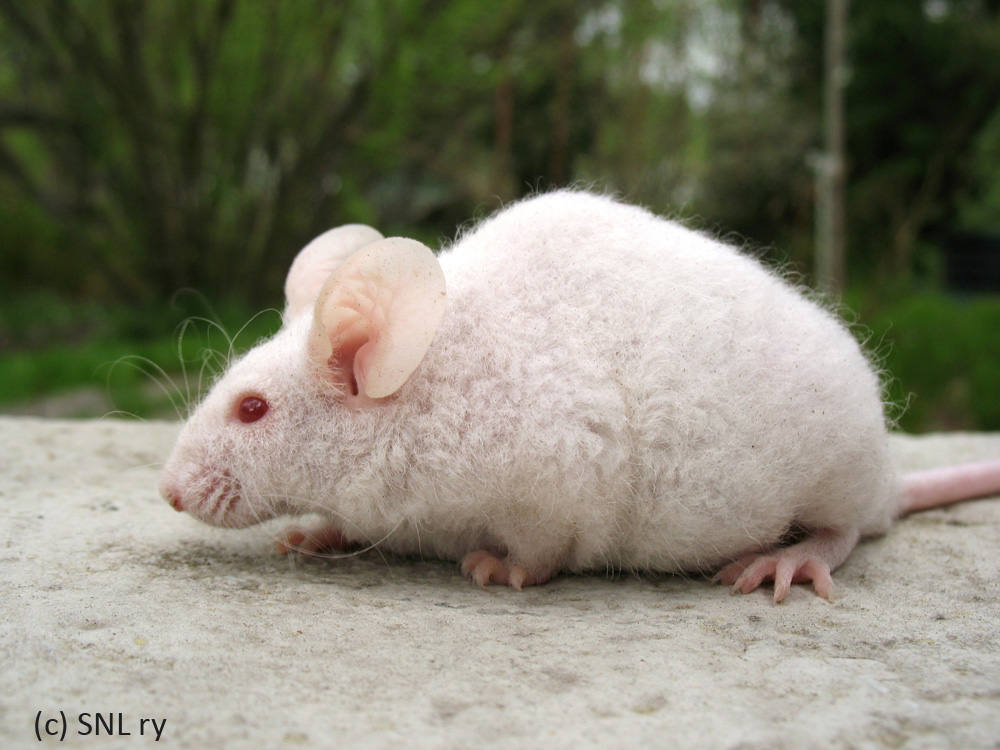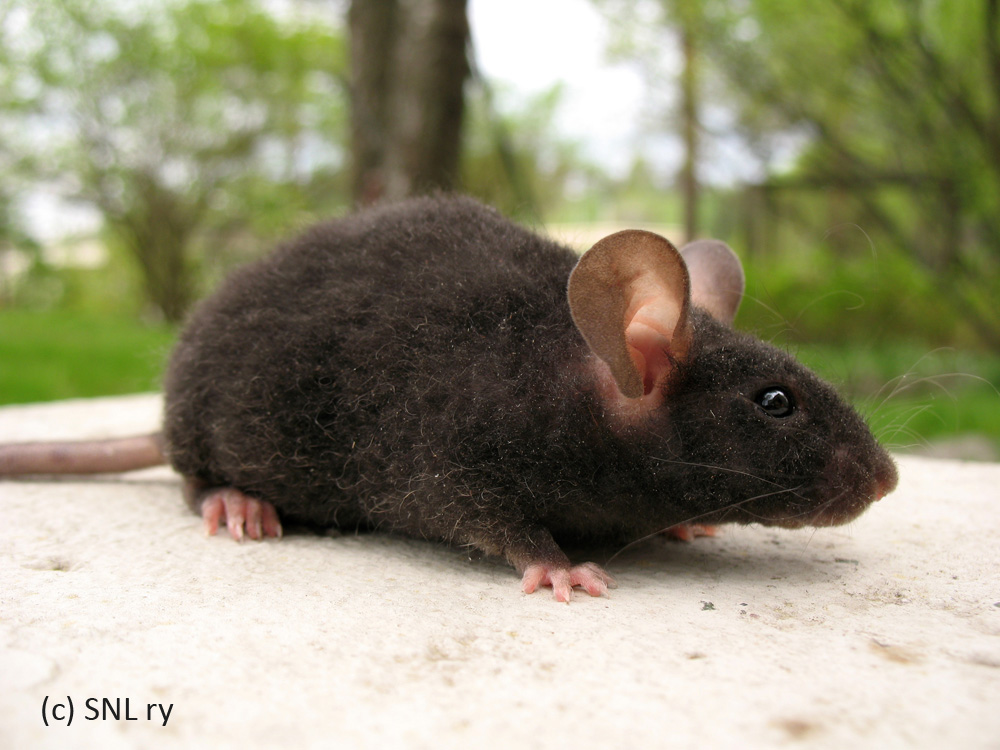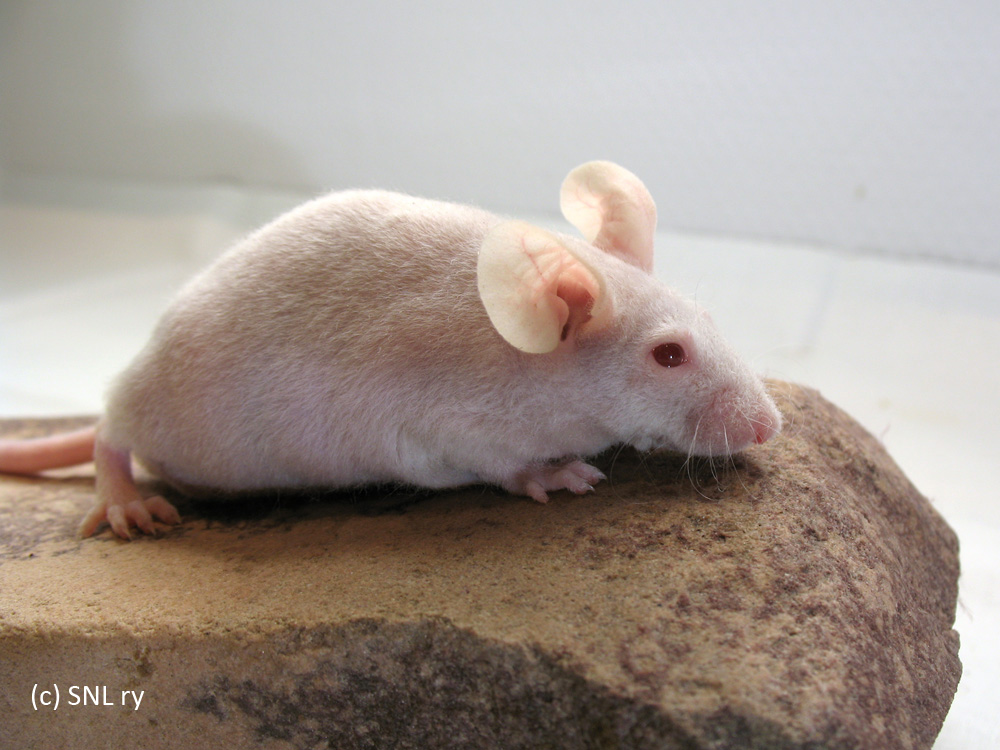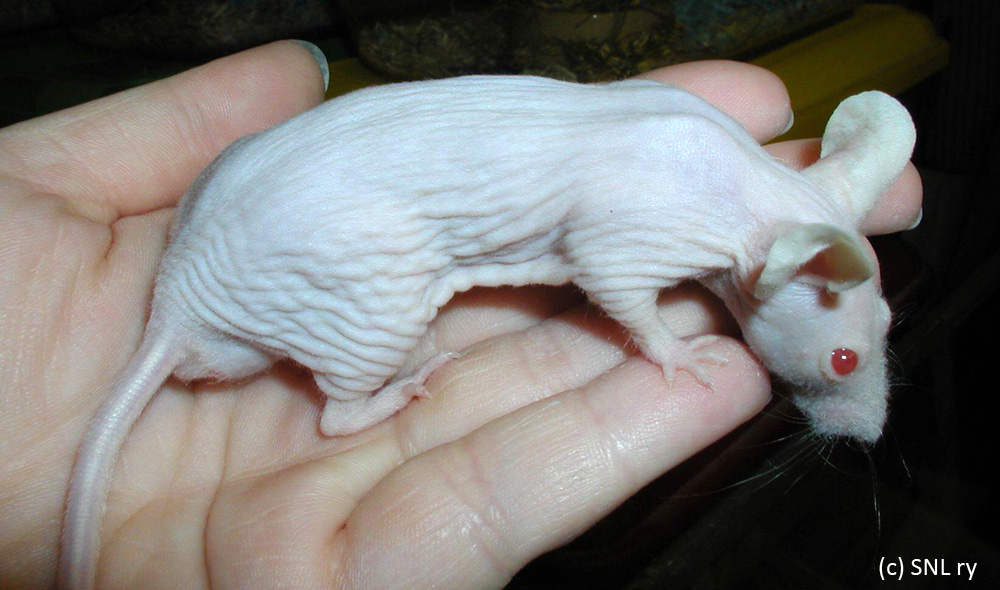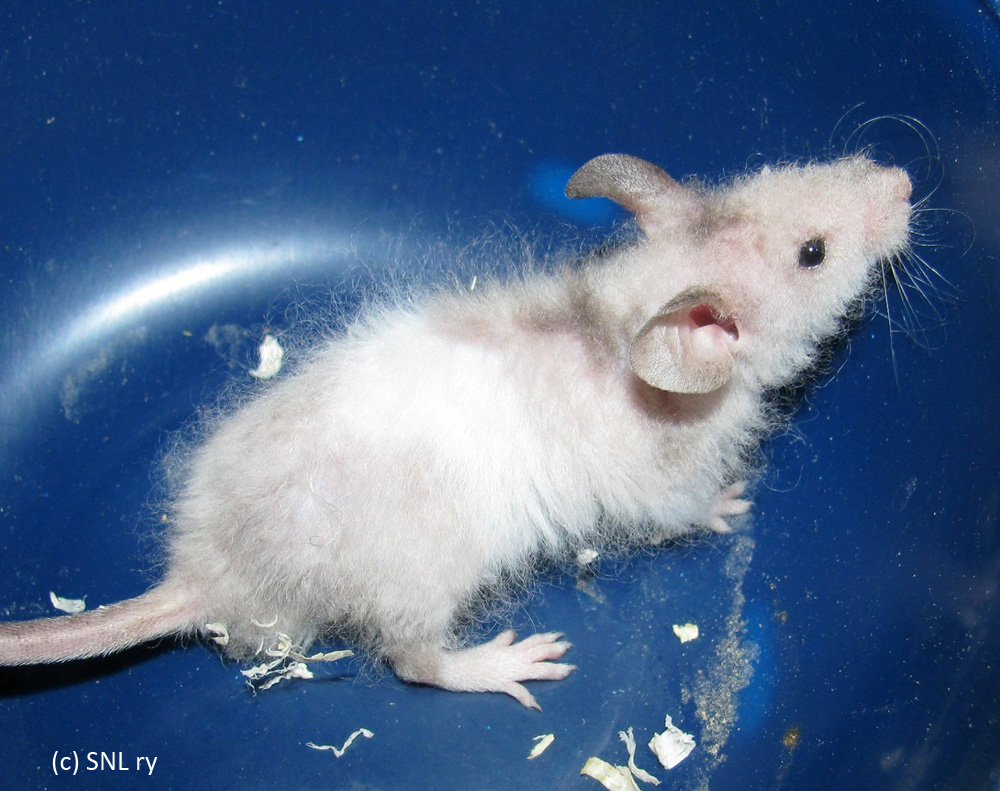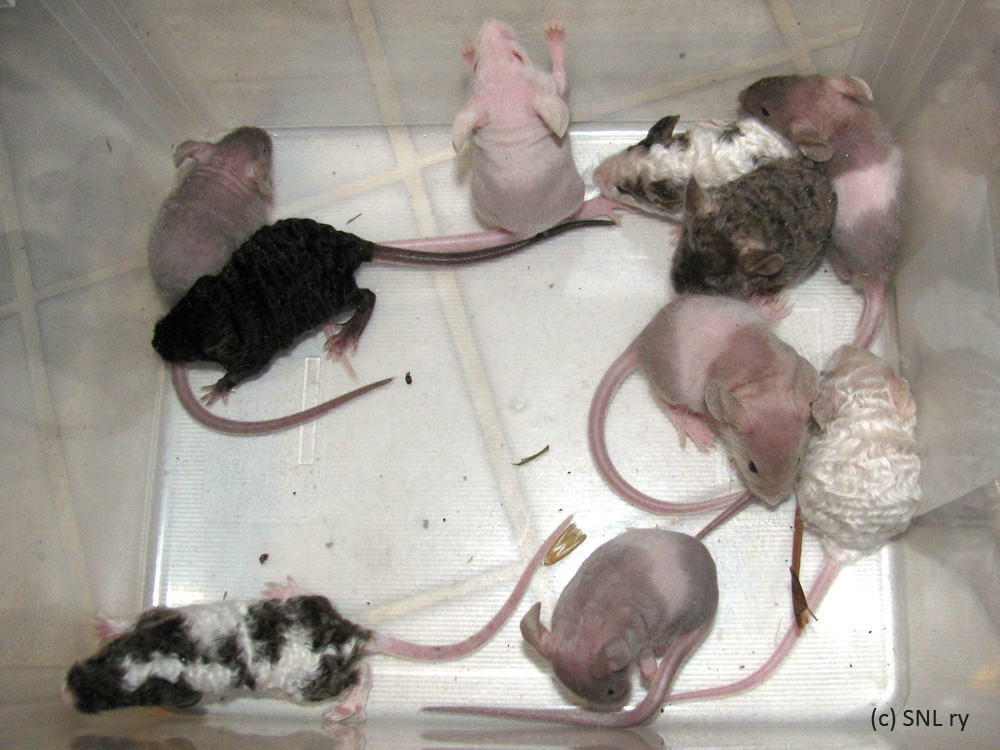Varieties
Coats
Fuzzy (fz)
Short hair fuzzy is marked down as sh fz, long hair as lh fz etc.
fz/fz
"The coat to be even and soft curl. There are fewer guard hairs than on normal coat. Whiskers curly. The effect of fuzzy on satin and coat lenght to be taken into account. Hairless spots and noticeably thin coat to be considered faults."
Breeding information below the pics.
General
Fuzzy is a recessive curly variety. Fuzzy mice have soft and dense "afro" curl resembling the wool of a young lamb, whereas the more commonly known astrex has wavy coat. Satinization and long hair are also less prominent on fuzzy than on astrex coat. Fuzzies were first imported to Finland in 2010 from Poland and the Netherlands. The variety got its place in the provisional standard in 2014.
Genetics
The genetical symbol of fuzzy is Sgk3fz. Inside the mouse fancy the symbol used is fz. The locus Sgk3 has several other alleles that produce a phenotype that resembles fuzzy, but whether any of these other genes can be found outside laboratories is unknown.
Fuzzy is a spontaneous mutation and it is fully recessive. Fuzzy can also be combined with other mutations that affect the length or quality of the coat. In Finland, these different combinations are marked with combinations of abbreviations: shorthair satin fuzzy as shs fz, longhair fuzzy as lh fz, shorthair satin abyssinian fuzzy as shs ab fz, etc.
However, though possible, not all combinations of coat qualities are very reasonable. Astrex and fuzzy together produce a curly mouse, in which the presence of the astrex gene is no longer clearly visible. Abyssinian fuzzy is typically lacking the clarity of rosettes and ridges. Satin or long hair work better, but satin may also make the fuzzy coat thinner, and long hair becomes less pretty as it loses much of its density. The best genetic background for show fuzzies is therefore shorthair fuzzy.
Breeding
Fuzzy can be bred with fuzzy x fuzzy matings, or using an occasional outcross to shorthair mice with nice type and the desired colour. Breeding fuzzy to shorthair typically yields only shorthair that carry fuzzy in the first generation. Breeding a fuzzy carrier back to fuzzy produces both shorthair and fuzzy in a 1:1 ratio.
Fuzzy babies are clearly recognisable by their curly whiskers usually by the age of 2 days. Later on they also differ from their non-fuzzy littermates in that their coat development is notably delayed. Fuzzy babies have very thin coats that become more dense with later molts.
In case there is a mixed litter with both fuzzy and non-fuzzy babies, it should be noted that the fuzzy ones grow somewhat slower. If the breeder intends to breed only fuzzy, he/she may want to consider culling the mixed litters to be fuzzy-only; this way all the babies will grow at the same pace, which ensures that the fuzzies get enough milk not having to fall behind in competition with their larger non-fuzzy littermates. Fuzzy mice usually catch their non-fuzzy littermates growth-wise after weaning age, and will grow to be normal sized adults.
Sometimes, however, a fuzzy baby may clearly fall behind in development even compared to its fuzzy siblings. These babies should be culled as they will not be viable. The reason for this phenomenon is not known at this point. Some fuzzies also appear to be slightly more prone to skin problems. This means that selective breeding is important to ensure the health of this variety.
Even at five weeks of age it may still be quite difficult to tell whether the fuzzy babies are also satin and/or longhair. The coat may still be so thin and short that possible long hair does not yet show itself properly ‐ even adult longhair fuzzies may show only sparse long guard hairs. Satinization may sometimes show quite well on young fuzzy mice, but "false positives" for satin are at least as common if identification is based only on how shiny the coat appears; especially thin fuzzy coat type may appear deceptively shiny without being satin. The most reliable way to tell if a fuzzy is satin is by looking at its teeth: the upper incisors of a satin mouse will be white, whereas non-satins have yellow upper incisors.
From one extreme to another: fuzzy coat types
The fuzzy phonotype varies a lot. According to the sources interviewed for this article these extremes are the result of mere selective breeding. The possibility that other alleles of fuzzy could be behind some of the phenotypes cannot, however, be fully excluded.
At one end of the phenotype scale is the fuzzy that the standard describes: short and dense curly coat, that becomes more and more dense and curly with each successive molt. Getting fuzzy to match the ideal that the standard describes requires work and selective breeding, even though mere flukes are also quite possible! The breeder should select for fuzzy mice with as short and dense curly coats as possible.
Common faults are very thin coat and, on the other hand, somewhat sparse and open looking shabby coat, that quite often is also longish (without being longhair). Out of these two faults the latter is in my opinion more severe, as it is harder to correct. Both these faults are strongly inherited. Despite the strong inheritance of coat quality, even parents with similar phenotypes may, according to the sources interviewed, produce both standard-like and very thinly coated fuzzies.
At the other end of the scale is a practically hairless mouse, that in some countries is called fuzzy hairless. The phenotype of these mice may be almost identical to heterozygous (dominant) nude mice, but the fuzzy hairless mice will always have whiskers. The fuzzy hairless is not completely without hair otherwise either: it appears hairless, but it is in fact covered with very thin silky fuzz, and has slightly more prominent hair only on its muzzle and base of tail.
Interestingly, this is precisely what the MGI describes as the phenotype of another fuzzy allele, namely Sgk3fz-ica:
From the front region, by age of 20-30 days, the weak, underdeveloped sparse hairs are lost [and] the pups remain completely lacking of hairs.
During the following 4-5 months, another 2-3 growth waves of sparse fuzzy hairs occur; then the adults remain without a coat with the exception of a perinasal tuft and some short hairs at the tail base.
Whatever the genotype of fuzzy hairless actually is, a breeder interested in breeding this variety should start by selecting for as thinly coated fuzzies as possible and breeding these together. Satin and astrex may help to "thin out" the coat even further.
Fuzzy hairless would be shown in Finland as nude, if only the mouse is hairless enough. The Finnish standard for nude (hairless) does not require the mouse to be completely lacking of hair, only that the mouse be "as hairless as possible". Nor does it require whiskers being absent.
Showing fuzzy
As the fuzzy coat develops slowly, it is worth while to patiently wait until the coat has more or less reached its maturity with decent coat density and curliness before showing them. Consequent molts may sometimes make showing (or trying to show...) fuzzies a bit frustrating, but on the other hand this is the reality with many other varieties as well.
Before taking a fuzzy to a show the owner may want to pay special attention to its nails, as some fuzzies tend to overgrow their nails. This should be taken into account also between shows so that the nails don't grow way too long. This abnormal nail growth seems to be especially typical for the longish and shabby fuzzy coat type.
The dense, curly fuzzy coat tends to collect dust and other fine particles from bedding material. Dark dust from peat bedding shows all too well in light coloured fuzzy coat, and correspondingly, light dust from wooden shavings in dark fuzzy coat. This is a good thing to remember when selecting bedding for show cages: for fuzzies the bedding should be free of any fine particles that could stick to the coat and make them look untidy.
In Finland, fuzzy mice are shown in the OTHER/AOV class (meaning any other coat variety than shorthair or shorthair satin), where it competes for BoB-placings, championships and yearly top ratings just as if the variety were in the actual standard. All possible coat combinations are not accepted for standard class, though: astrex fuzzies and abyssinian fuzzies have been excluded.

